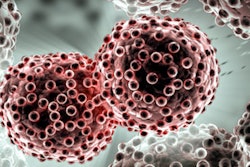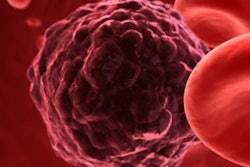
Harvard researchers have developed an artificial intelligence (AI) algorithm capable of analyzing routine CT scans to predict how well lung cancer patients will respond to treatment, as well as their likelihood of survival, according to an article published online April 22 in Clinical Cancer Research.
The group, led by Hugo Aerts, PhD, sought to improve upon the existing methods for predicting a cancer patient's response to therapy by turning to AI modeling. Aerts is the director of the Computational and Bioinformatics Laboratory at Harvard's Dana-Farber Cancer Institute and Brigham and Women's Hospital.
 Hugo Aerts, PhD, of Harvard Medical School.
Hugo Aerts, PhD, of Harvard Medical School.Aerts and colleagues developed a deep-learning model based on ImageNet, a convolutional neural network created at Princeton University and Stanford University that can identify objects from the most relevant features of images. To train their deep-learning model, the investigators applied it to the CT scans of 179 patients with stage III non-small cell lung cancer (NSCLC) who had previously received chemoradiation therapy.
The CT data consisted of up to four scans per patient, including those obtained before treatment and at one, three, and six months after treatment. The researchers subsequently validated the AI model on a dataset of 178 CT scans from 89 NSCLC patients who had undergone chemoradiation and surgery.
"Radiology [CT] scans are captured routinely from lung cancer patients during follow-up examinations and are already digitized data forms, making them ideal for artificial intelligence applications," Aerts said in a statement to the American Association for Cancer Research (AACR). "Deep-learning models that quantitatively track changes in lesions over time may help clinicians tailor treatment plans for individual patients and help stratify patients into different risk groups for clinical trials."
Overall, the AI model was able to predict the patients' two-year survival with an area under the curve (AUC) of 0.58 by analyzing the pretreatment CT scans and an AUC of 0.74 by analyzing a combination of pretreatment and post-treatment CT scans. The AI model also determined that the patients it categorized as having a low mortality risk were six times more likely to survive than the high-risk patients.
Furthermore, the deep-learning model was more efficient at predicting distant metastasis, cancer progression, and local regional recurrence than a standard set of clinical parameters such as cancer stage and tumor size, Aerts noted.
"Our research demonstrates that deep-learning models integrating routine [CT] scans obtained at multiple time points can improve predictions of survival and cancer-specific outcomes for lung cancer," he said. "By comparison, a standard clinical model relying on stage, gender, age, tumor grade, performance, smoking status, and tumor size could not reliably predict two-year survival or treatment response."
The promising outcome of this proof-of-principle research warrants evaluation of the AI model in prospective clinical trials involving more data, he concluded.




















